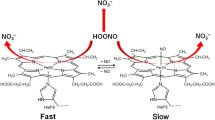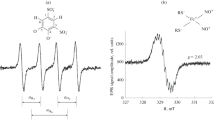Summary
In recent years increased attention has been focused on the reduced forms of coenzyme Q as antioxidant compounds inhibiting lipid peroxidation in model systems and in biological membranes, but in spite of extensive experimental evidences the molecular mechanisms responsible for the antioxidant activity of ubiquinones are still debated. Ferrylmyoglobin and/or its free radical form are regarded as powerful oxidizing agents capable of promoting oxidation of essential cellular constituents, particularly cell membranes. Therefore, we investigated the effects of ubiquinol on the formation and survival of ferryl species of myoglobin and on metmyoglobin itself. The addition of a threefold molar excess of hydrogen peroxide to a solution of metmyoglobin induces the rapid formation of a compound with the spectral characteristics of ferrylmyoglobin. The reaction is complete within 4 min, producing up to 76% of ferrylmyoglobin, which remains stable for at least 30 min. The addition of ubiquinol-1 to the same solution provokes a rapid and progressive reduction of ferrylmyoglobin to metmyoglobin and oxymyoglobin. Ubiquinol-1, furthermore, is also capable of protecting metmyoglobin against oxidation when added in the solution before hydrogen peroxide. Ubiquinol-1, indeed, is effective at both limiting the maximal ferrylmyoglobin level attained (59% inhibition) and accomplishing complete removal of the ferryl form (in about 15 min). The results demonstrate that ubiquinol is capable of reducing both ferrylmyoglobin and metmyoglobin to oxymyoglobin, providing a novel antioxidant mechanism for coenzyme Q.
Similar content being viewed by others
Abbreviations
- Mb:
-
myoglobin
- MbIIO2 :
-
oxymyoglobin
- MbIII :
-
metmyoglobin
- MbIV :
-
ferrylmyoglobin
- MbIV :
-
ferryl-myoglobin free radical
- CoQ1H2 :
-
ubiquinol-1
- CoQ1 :
-
ubiquinone-1
References
Arduini A, Eddy L, Hochstein P (1990) The reduction of ferrylmyoglobin by ergothioneine: a novel function for ergothioneine. Arch Biochem Biophys 281:41–43
Beyer RE (1990) The participation of coenzyme Q in free radical production and antioxidation. Free Rad Biol Med 8:545–565
Buffinton G, Cadenas E (1988) Reduction of ferrylmyoglobin to metmyoglobin by quinonoid compounds. Chem Biol Interact 66:233–250
Frei B, Kim MC, Ames BN (1990) Ubiquinol-10 is an effective lipid-soluble antioxidant at physiological concentrations. Proc Natl Acad Sci USA 87:4879–4883
Galaris D, Cadenas E, Hochstein P (1989) Glutathione-dependent reduction of peroxides during ferryl- and met-myoglobin interconversion: a potential protective mechanism in muscle. Free Rad Biol Med 6:473–478
Galaris D, Cadenas E, Hochstein P (1989) Redox cycling of myoglobin and ascorbate: a potential protective mechanism against oxidative reperfusion injury in muscle. Arch Biochem Biophys 273:497–504
Galaris D, Eddy L, Arduini A, Cadenas E, Hochstein P (1989) Mechanisms of reoxigenation injury in myocardial infarction: implications of a myoglobin redox cycle. Biochem Biophys Res Comms 160:1162–1168
Harada K, Tamura M, Yamazaki I (1986) The two-electron reduction of sperm whale ferryl-myoglobin by ethanol. J Biochem 100:499–504
Kagan VE, Serbinova EA, Koynova GM, Kitanova SA, Tyurin VA, Stoytchev TS, Quinn PJ, Packer L (1990) Antioxidant action of ubiquinol homologues with different isoprenoid chain length in biomembranes. Free Rad Biol Med 9:117–126
Kanner J, Harel S (1985) Initiation of membranal lipid peroxidation by activated metmyoglobin and methemoglobin. Arch Biochem Biophys 237:314–321
Kanner J, Harel S (1985) Lipid peroxidation and oxidation of several compounds by H2O2 activated metmyoglobin. Lipids 20:625–628
Lang JK, Gohil K, Packer L (1986) Simultaneous determination of tocopherols, ubiquinols, and ubiquinones in blood, plasma, tissue homogenates, and subcellular fractions. Anal Biochem 157:106–116
Marubayashi S, Dohi K, Yamada K, Kawasaki T (1984) Changes in the level of endogenous coenzyme Q homologues, α-tocopherol, and glutathione in rat liver after hepatic ischemia and reperfusion, and the effect of pretreatment with coenzyme Q10. Biochem Biophys Acta 797:1–9
Mellors A, Tappel AL (1966) The inhibition of mitochondrial peroxidation by ubiquinone and ubiquinol. J. Biol Chem 241:4353–4356
Rossi E, Lombardo A, Testa M, Lippa S, Oradei A, Littarru GP, Lucente M, Coppola E, Manzoli U (1991) Coenzyme Q10 in ischaemic cardiopathy. In: Folkers K, Littarru GP, Yamagamy T (eds) Biomedical and clinical aspects of coenzyme Q, vol 6. Elsevier, Amsterdam, pp 321–326
Simonsen R, Folkers K, Komorowski J, Komorowska A, Lyson T (1991) Restoration of impaired cardiac function of patient with muscolar dystrophies and neurogenic atrophies by therapy with coenzyme Q10. In: Folkers K, Littarru GP, Yamagamy T (eds) Biomedical and clinical aspects of coenzyme Q, vol 6. Elsevier, Amsterdam, pp 363–373
Turner JJO, Rice-Evans CA, Davies MJ, Newman SR (1991) The formation of free radicals by cardiac myocytes under oxidative stress and the effects of electron-donating drugs. Biochem J 277:833–837
Whitburn KD (1987) The interaction of oxymyoglobin with hydrogen peroxide: the formation of ferrylmyoglobin at moderate excesses of hydrogen peroxide. Arch Biochem Biophys 253:419–430
Author information
Authors and Affiliations
Rights and permissions
About this article
Cite this article
Mordente, A., Martorana, G.E., Santini, S.A. et al. Antioxidant effect of coenzyme Q on hydrogen peroxide-activated myoglobin. Clin Investig 71 (Suppl 8), S92–S96 (1993). https://doi.org/10.1007/BF00226847
Issue Date:
DOI: https://doi.org/10.1007/BF00226847




